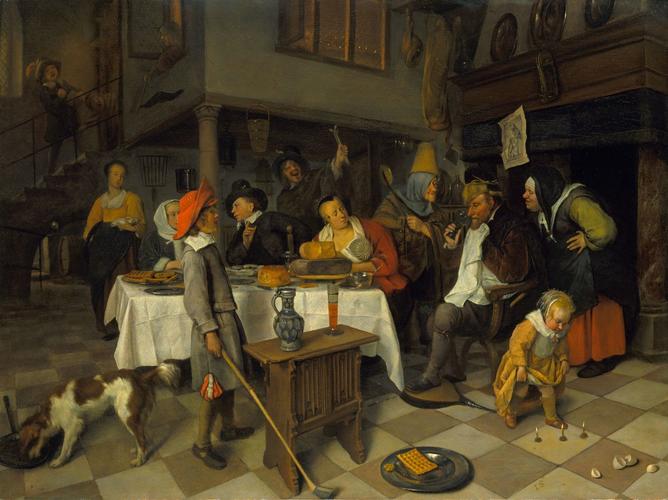A Twelfth Night Feast: 'The King drinks' c.1661
Oil on panel | 40.4 x 54.5 cm (support, canvas/panel/stretcher external) | RCIN 407489
-
The subject of the painting is the celebration of Twelfth Night (6 January), the Feast of the Epiphany, when the three kings travelled to Bethlehem to offer gifts to the new-born Christ Child. In Holland the feast is known as Driekoningenaroud and originated in performances of the plays devised around the story of Herod organised by the rederijkers (chambers of rhetoric). Twelfth Night was therefore a religious festival of Catholic origin retained in Protestant Holland, mainly as a secular festival reuniting the family in a special celebration. The tradition was that each family chose a ‘king’ for the occasion, either by drawing lots or else by means of a bean or silver coin concealed in a loaf or cake. The ‘king’ then processed from the house, followed by children wearing baskets on their heads and with figures representing the Fool and the Glutton in grotesque costumes, together with other members of his ‘court’. Songs referring to Herod and the story of the three magi were sung. Later, the procession made its way to a tavern or returned to the house for further celebrations. Details of the proceedings differed according to town. The ‘king’ was not necessarily meant to represent one of the magi but, as here, might refer to the misrule of Herod. In three other renderings of the subject Steen depicts a child as ‘king’ (Museum of Fine Arts, Boston, dated 1662; County Museum of Art, Los Angeles, c.1666-7; and Staatliche Museen, Kassel, dated 1668).
For the present composition, acquired by George IV with the collection of Sir Francis Baring, Steen has seated the ‘king’ on the right in the hallway of a house, with his foot on a pair of bellows. He is flanked by a man dressed as a fool and a woman representing gluttony. At lower right a small girl hitches up her skirt to jump over the three candles symbolising the three magi. Waffles, as seen on the plate in the foreground, were traditionally consumed during the course of celebrations and the broken eggshells and the frying pan being licked by the dog are related to this. At the top of the stairs on the left is a young man singing while playing a rommelpot (an earthenware pot half-filled with water covered with a stretched pig’s bladder). He is part of a group of entertainers who wandered the streets singing and carrying a paper star (half-visible at the door) representing the biblical star that guided the three magi to Bethlehem. The artist has portrayed himself as the man holding up three clay pipes, positioned just above the seated woman feeding a child. Attached to the mantelpiece is a print of a monkey seated before an owl, which probably illustrates a Dutch proverb. Some aspects of the composition (for example, the boy in the foreground holding a golf club) remain unexplained and it is possible that Steen has introduced an additional moral significance to the narrative.
Signed lower right corner: 'JS'
Catalogue entry adapted from Enchanting the Eye: Dutch paintings of the Golden Age, London, 2004Provenance
Purchased by George IV from Sir Thomas Baring as part of a group of 86 Dutch and Flemish paintings, most of which were collected by Sir Thomas’s father, Sir Francis Baring; they arrived at Carlton House on 6 May 1814; recorded in the Dining Room at Carlton House in 1819 (no 76); in the Picture Gallery at Buckingham Palace in 1841 (no 85)
-
Medium and techniques
Oil on panel
Measurements
40.4 x 54.5 cm (support, canvas/panel/stretcher external)
58.5 x 72.3 x 8.3 cm (frame, external)
Category
Object type(s)
Other number(s)










